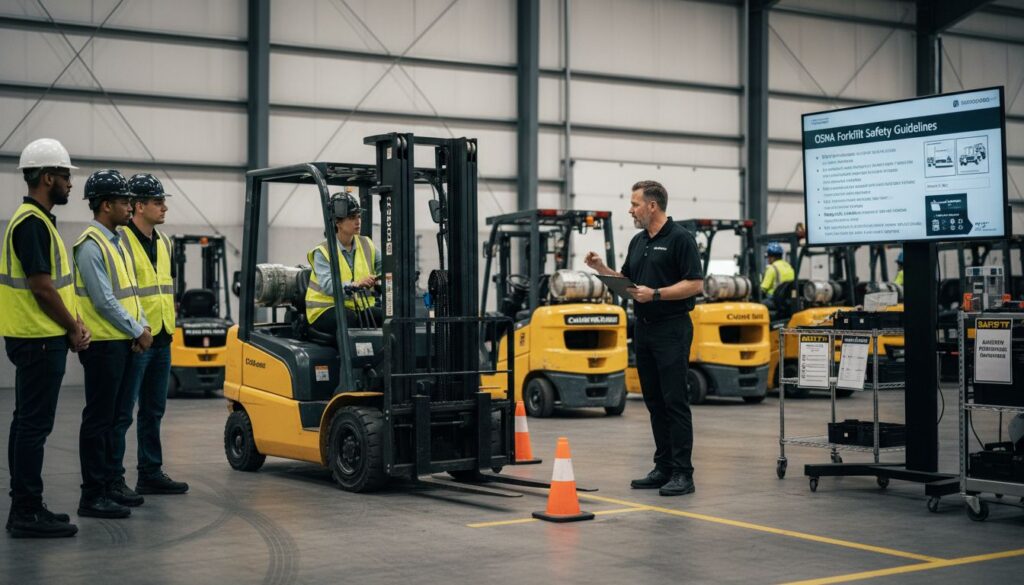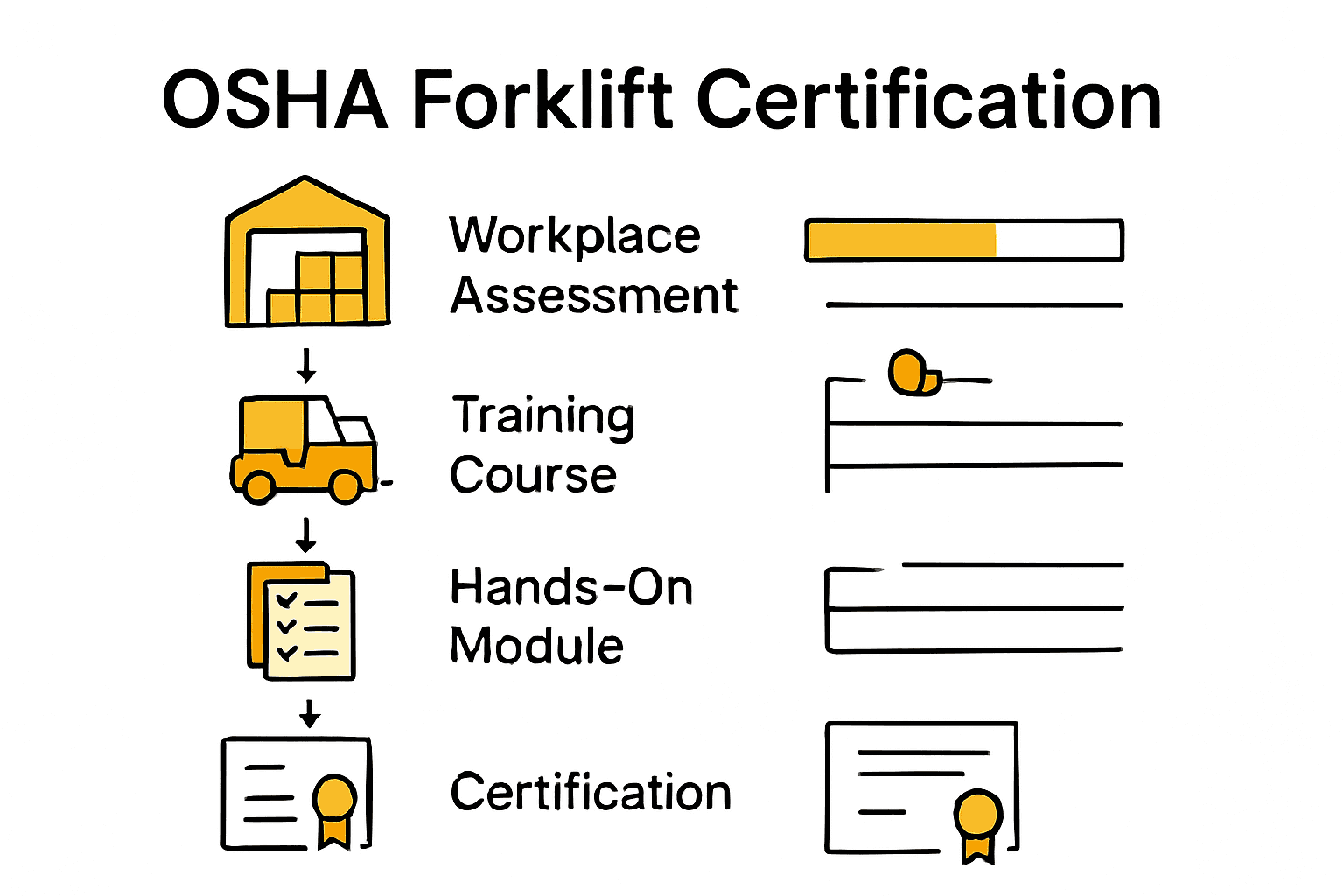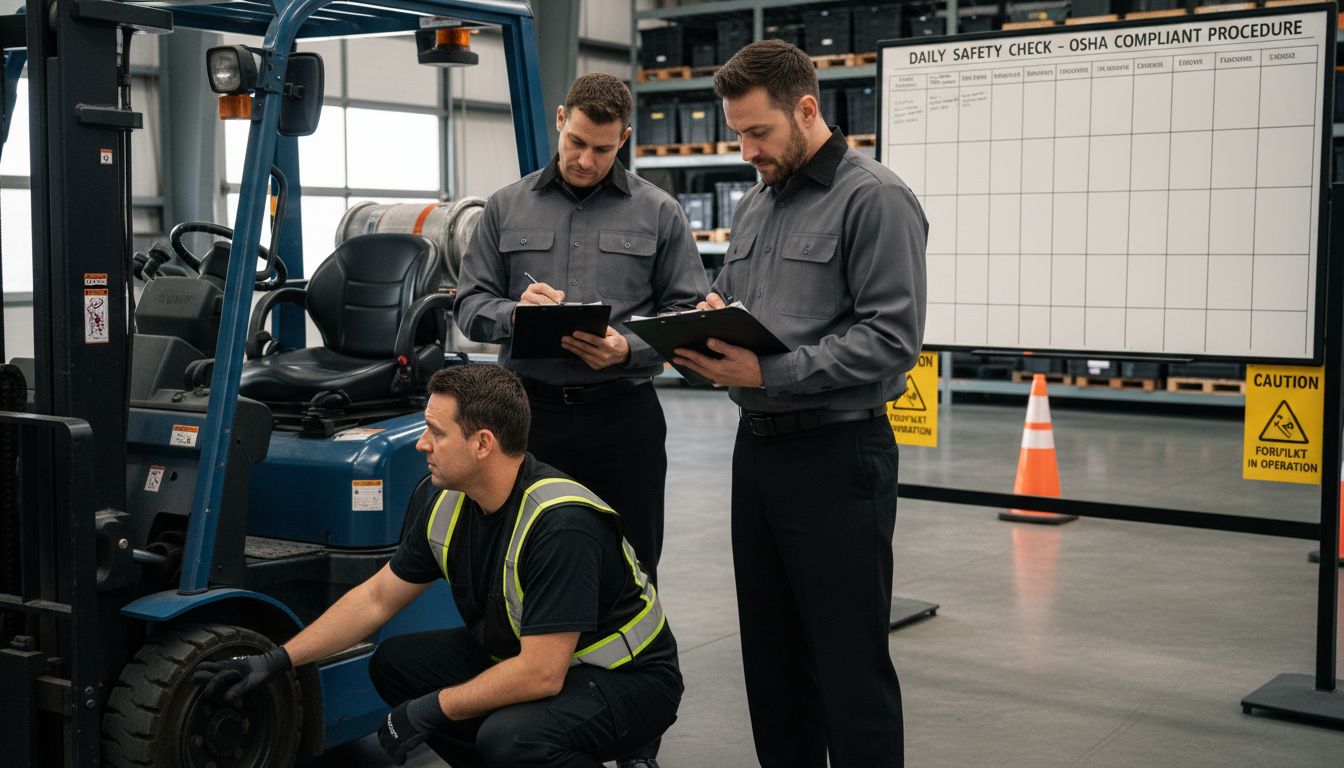
More than 7,000 forklift-related injuries are reported in US workplaces every year, yet many of these incidents are preventable with proper certification and training. Understanding OSHA forklift certification is key to protecting both employees and businesses from serious risks and costly penalties. This guide breaks down the exact steps every employer needs to follow to ensure their forklift operators are fully trained, compliant, and prepared for any challenge on the job.
| Key Point | Explanation |
|---|---|
| 1. Evaluate training needs thoroughly | Assess your workplace’s specific forklift types and potential hazards to tailor training programs effectively. |
| 2. Choose compliant certification courses | Ensure selected courses meet OSHA standards and cover theory, practical skills, and performance evaluation. |
| 3. Balance theory with hands-on training | Develop training modules that combine theoretical knowledge with practical application for safety and competence. |
| 4. Regularly assess operator competence | Conduct evaluations at least every three years to ensure continued operator proficiency and safety awareness. |
| 5. Maintain comprehensive training records | Keep detailed documentation of training certifications and assessments to demonstrate compliance and support safety efforts. |
 |
|
Successfully navigating OSHA forklift certification requires a strategic approach to understanding training and compliance requirements. This step involves carefully assessing your organization’s specific workplace needs and aligning them with federal safety standards.
According to OSHA, employers must develop training programs tailored to the specific safety and health aspects of employees’ jobs. This means your training cannot be a one-size-fits-all solution. You need to consider factors like the specific types of powered industrial trucks in your workplace, the unique environments where they will be operated, and the particular tasks your operators will perform.
To effectively evaluate your training requirements, start by conducting a comprehensive workplace assessment. This involves identifying the types of forklifts used, analyzing potential workplace hazards, and understanding the specific skills operators need. OSHA’s directive CPL 2-128 emphasizes the necessity of comprehensive training that covers all types of powered industrial trucks and their operational requirements. Your assessment should include:
Pro tip: Documentation is key. Maintain detailed records of your training evaluation process, as these will be critical during OSHA inspections and can demonstrate your commitment to workplace safety.
Once you have completed your initial assessment, you’ll be prepared to move forward with designing a targeted training program that meets both OSHA standards and your specific operational needs.
Selecting the right forklift certification course is crucial for ensuring workplace safety and regulatory compliance. This step will help you navigate the various training options available and choose a program that meets OSHA standards and your specific operational needs.
OSHA’s eTool outlines three essential components of a comprehensive forklift training program: formal instruction, practical training, and evaluation of the operator’s performance in the workplace. When selecting a certification course, look for programs that cover all these critical aspects. The course should include detailed classroom or online theoretical training, hands on practical skills development, and a thorough performance assessment.
Different types of forklift certification courses are available, and your selection should depend on several key factors:
Iowa State University’s Environmental Health and Safety notes that forklift operator safety training is typically a one time requirement unless the operator is involved in an accident or observed operating unsafely. This means you want a comprehensive initial certification that thoroughly prepares operators for real world scenarios.
Pro tip: Always verify that the certification course is fully OSHA compliant and provides documentation you can use for workplace safety records.
Once you select the appropriate certification course, you will be ready to move forward with the actual training process and ensure your operators are fully prepared to work safely and efficiently.
Successfully training forklift operators requires a balanced approach that combines comprehensive theoretical knowledge with practical skill development. This step focuses on creating a robust training program that ensures operators are both intellectually prepared and physically capable of safe forklift operation.
OSHA emphasizes that effective training should integrate multiple learning methods including lecture, interactive computer learning, video training, and written materials. The goal is to provide a comprehensive learning experience that covers not just operational skills but also critical safety protocols, equipment understanding, and workplace awareness.
Your training modules should be strategically designed to address both theoretical and practical aspects of forklift operation. Montana State University’s Safety and Risk Management Office highlights the critical importance of covering safe operation, inspection, maintenance, and management procedures. Effective training should include:
Pro tip: Create a progressive learning structure where theoretical knowledge builds the foundation, and practical modules allow operators to apply their understanding in controlled training environments.
Once your theory and hands on modules are implemented, you will be ready to move forward with individual operator performance evaluations to ensure complete competency and workplace safety.
Assessing operator competence is a critical component of maintaining workplace safety and ensuring OSHA compliance. This step focuses on developing a comprehensive evaluation process that goes beyond basic skill observation to truly measure an operator’s proficiency and safety awareness.
OSHA requires that each operator’s performance be evaluated at least once every three years to ensure continued competence and safety in forklift operations. This means your assessment should be more than a simple checklist it needs to be a thorough examination of both technical skills and safety consciousness.
A comprehensive competence assessment should include multiple evaluation components:
Iowa State University reinforces the importance of consistent evaluation by mandating driving assessments during initial certification and every three years thereafter. This approach ensures that operators maintain their skills and adapt to potential workplace changes or new safety standards.
Pro tip: Create a standardized evaluation form that scores operators across multiple competency areas, allowing for objective and consistent performance tracking.
Once you complete the competence assessment, you will have a clear understanding of each operator’s strengths and areas for potential additional training or improvement.

Issuing certification and maintaining accurate training records is a critical final step in your forklift operator training program. This process ensures regulatory compliance and provides a comprehensive documentation trail that protects both your organization and your operators.
OSHA mandates specific requirements for certification documentation. Employers must certify each operator’s training by maintaining detailed records that include the operator’s name, precise training date, evaluation date, and the names of individuals who conducted the training or evaluation. This documentation serves as your primary evidence of compliance during potential workplace inspections.
Your certification and record maintenance process should encompass several key elements:
Montana State University’s Safety and Risk Management Office emphasizes the importance of maintaining centralized records of operator certifications, inspections, and incident reports. This systematic approach ensures not just compliance but also provides a robust mechanism for tracking operator development and workplace safety trends.
Pro tip: Implement a digital record keeping system that allows easy retrieval, updates, and secure storage of all training documentation.
With your certification and records systematically managed, you have successfully completed a comprehensive OSHA compliant forklift training program that prioritizes workplace safety and operator competence.
Forklift training programs can feel overwhelming when you must navigate OSHA requirements, ensure operator competence, and maintain detailed certification records. This guide highlights the challenges of developing tailored training, combining theory with hands-on practice, and tracking safety compliance effectively. If you want to simplify these complexities and achieve certified success with confidence, discover proven solutions designed to meet the exact needs outlined here.

Start with Forkliftacademy.com, your trusted partner for OSHA-compliant forklift certification and training solutions. Whether you need personalized online courses, onsite training, or comprehensive business programs, we support every step to boost operator safety and compliance. Explore the full range of Forklift License Archives – Top Osha Forklift Certification resources and get expert safety guidance in our Forklift Safety Archives – Top Osha Forklift Certification. Ready to take action on workplace safety and elevate your operators’ skills? Visit https://forkliftacademy.com now to start your journey toward OSHA certification success.
To evaluate training requirements, conduct a comprehensive workplace assessment that identifies the types of forklifts, potential hazards, and required operator skills. Start by documenting the specific equipment and conditions in your workplace to align with OSHA standards.
A forklift certification course should include formal instruction, practical training, and an evaluation of the operator’s performance. Ensure the course is comprehensive and addresses both theoretical knowledge and hands-on skills applicable to your specific workplace environment.
Implement training modules that balance theoretical instruction with practical skills development. Create a program that covers safety protocols, equipment operation, and real-world workplace challenges through structured learning methods.
Operator competence assessments should evaluate practical driving skills, knowledge of safety protocols, and emergency response capabilities. Use a standardized evaluation form to objectively score operators across these areas for consistent tracking of performance.
Maintain detailed training records that include each operator’s certification, training dates, and performance evaluations. Organize these records in a digital system for easy retrieval and updates, ensuring compliance with OSHA requirements.
Forklift operators must be evaluated every three years to ensure continued competence and safety. Schedule periodic recertification assessments to track operator skills and adapt to any changes in workplace safety standards.